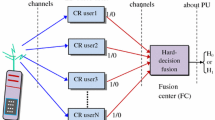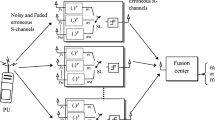Abstract
Cognitive radio (CR) is developed as one of the important techniques to improve the utilization of the radio spectrum. A CR node shares the radio spectrum with a licensed primary user opportunistically. In this paper, we study the performance of an energy-efficient cooperative cognitive radio system (CCRS) in the presence of noise plus different fading conditions under channel error constraints. Two fading environments namely, Nakagami-m and Weibull fading are considered and performance characteristics are evaluated. More precisely, Every CR node uses the similar energy detectors to sense a primary user, and forwards their knowledge to fusion center (FC) as one bit binary information. Different hard-decision fusion operations are carried out at FC to take the global decision about the status of the primary user. The analytical and simulation models related to noise and fading for calculating missdetection performance, total error performance, and sensing time and throughput/energy efficiency trade-off are developed. Analytical frameworks are validated via computer based simulations. For comparison purposes, we also investigate the performance of CCRS in Rayleigh fading with and without channel errors constraints. Further, the performance CCRS is investigated for various hard-decision fusion rules under several parameters of the system. Finally, an optimal values of the number of CR nodes and sensing threshold for different fusion rules, and sub-optimal hard-decision fusion rule are also investigated. The energy efficiency is enhanced by 19% when CCRS is operated over Nakagami-m fading environment as compared to Rayleigh fading environment for a fixed parameter values of the network.


















Similar content being viewed by others
References
Ball, S., Ferguson, A., & Rondeau, T. W. (November 2005). Consumer applications of cognitive radio defined networks. In Proceedings of IEEE IEEE symposium on new frontiers in dynamic spectrum access networks (pp. 518–525). Baltimore.
Gorcin, A., & Arslan, H. (October 2008). Public safety and emergency case communications: Opportunities from the aspect of cognitive radio. In: Proceedings of IEEE symposium on new frontiers in dynamic spectrum access networks (pp. 1–10). Chicago.
Sasipriya, S., & Vigneshram, R. (December 2016). An overview of cognitive radio in 5G wireless communications. In: Proceedings of IEEE Computational Intelligence and Computing Research (ICCIC) (pp. 1–5). Chennai.
Zhang, Z., Zhang, W., Zeadally, S., Wang, Y., & Liu, Y. (2015). Cognitive radio spectrum sensing framework based on multi-agent arc hitecture for 5G networks. IEEE Communications Letters, 22(6), 34–39.
Ghasemi, A., & Sousa, E. S. (2007). Opportunistic spectrum access in fading channels through collaborative sensing? IEEE Transactions on Wireless Communications, 2(2), 71–82.
Digham, F. F., Alouini, M.-S., & Simon, M. K. (2007). On the energy detection of unknown signals over fading channels. IEEE Transactions on Communications, 55(1), 21–24.
Zhang, W., Mallik, R., & Letaief, K. B. (2009). Optimization of cooperative spectrum sensing with energy detection in cognitive radio networks. IEEE Transactions on Wireless Communications, 8(12), 5761–5766.
Nallagonda, S., Chandra, A., Roy, S. D., Kundu, S., Kukolev, P., & Prokes, A. (2016). Detection performance of cooperative spectrum sensing with hard decision fusion in fading channels. International Journal of Electronics (Taylor and Francis), 103(2), 297–321.
Nallagonda, S., Chandra, A., Roy, S. D., & Kundu, S. (2017). Analytical performance of soft data fusion-aided spectrum sensing in hybrid terrestrial-satellite networks. International Journal of Satellite Communications and Networking, 35(5), 461–480.
Nallagonda, S., Roy, S. D., Kundu, S., Ferrari, G., & Raheli, R. (2018). Censoring-based cooperative spectrum sensing with improved energy detectors and multiple antennas in fading channels. IEEE Transactions on Aerospace and Electronic Systems, 54(2), 537–553.
Angueira, P., Fadda, M., Morgade, J., Murroni, M., & Popescu, V. (2016). Field measurements for practical unlicensed communication in the UHF band. Telecommunication Systems, 61(3), 443–449.
Banavathu, N. R., & Khan, M. Z. A. (March 2016). On the throughput maximization of cognitive radio using cooperative spectrum sensing over erroneous control channel. In: Proceedings of IEEE National Conference on Communication (NCC) (pp. 1–6), IIT Guwahati, India.
Liang, Y. C., Zeng, Y., Peh, E. C. Y., & Hoang, A. T. (2008). Sensing-throughput tradeoff for cognitive radio networks. IEEE Transactions on Wireless Communications, 7(4), 1326–1337.
Shi, Z., Teh, K. C., & Li, K. H. (2013). Energy efficient joint design of sensing and transmission durations for protection of primary user in cognitive radio systems. IEEE Communications Letters, 17(3), 565–568.
Wu, Y., & Tsang, D. H. K. (2011). Energy efficient spectrum sensing and transmission for cognitive radio system. IEEE Communications Letters, 15(5), 545–547.
Balam, S. K., Siddaiah, P., & Nallagonda, S. (May 2018). Throughput analysis of cooperative cognitive radio network over generalized \(\kappa -\mu \) and \(\eta -\mu \) fading channels. In: Wireless Networks (pp. 1–14). Springer. https://doi.org/10.1007/s11276-018-1758-4.
Kiran Kumar, G., Mahendar, G., & Nallagonda, S. (February 2018). Cooperative spectrum sensing in log-normal shadowing environment with erroneous sensing and reporting channels. In: Proceedings of IEEE International Conference on on Advances in Electronics, Computer and Communications (ICAECC) (pp. 1–5). Bangalore, India.
Nallagonda, S., Chandra, A., Roy, S. D., & Kundu, S. (February 2018). The effects of channel knowledge on cooperative spectrum sensing in Nakagami-\(n/q\) fading channels. In: Wireless Networks (pp. 1–13). https://doi.org/10.1007/s11276-018-1685-4.
Bhowmick, A., Roy, S. D., & Kundu, S. (2016). Sensing throughput trade-off for an energy efficient cognitive radio network under faded sensing and reporting channel. International Journal of Communication Systems, 29, 1208–1218.
-Juarez, M. C., & Ghogho, M. (2011). Spectrum sensing and throughput trade-off in cognitive radio under outage constraints over nakagami fading. IEEE Communications Letters, 15(10), 1110–1113.
Quang, P. M., Duy, T. T., & Bao, V. N. Q. (December 2016). Performance evaluation of underlay cognitive radio networks over Nakagami-\(m\) fading channels with energy harvesting. In: Proceedings of IEEE International Conference on Advanced Technologies for Communications (ATC) (pp. 108–113). Vietnam.
Van Nguyen, B., Jung, H., Har, D., & Kim, K. (2018). Performance analysis of a cognitive radio network with an energy harvesting secondary transmitter under Nakagami-\(m\) fading. IEEE Access, 6, 4135–4144.
Musavian, L., & Aissa, S. (2010). Effective capacity of delay-constrained cognitive radio in Nakagami fading channels. IEEE Transactions on Wireless Communications, 9(3), 1054–1062.
Han, B., Zeng, M., Guo, Q., Jiang, H., Zhang, Q., & Feng, L. (2018). Energy-efficient sensing and transmission for multi-hop relay cognitive radio sensor networks. China Communications, 15(9), 106–117.
Haider, F., Wang, C. X., Haas, H., Hepsaydir, E., Ge, X., & Yuan, D. (2015). Spectral and energy efficiency analysis for cognitive radio networks. IEEE Transactions on Wireless Communications, 14(6), 2969–2980.
Amjad, M., Rehmani, M. H., & Mao, S. (2018). Wireless multimedia cognitive radio networks: A comprehensive survey. IEEE Communications Surveys and Tutorials, 20(2), 1056–1103.
Tang, L., Chen, Y., Hines, E. L., & Alouini, M.-S. (2011). Effect of primary user traffic on sensing-throughput tradeoff for cognitive radios. IEEE Transactions on Wireless Communications, 10(4), 1063–1068.
Cao, H., & Yang, S. (April 2017). Sensing-throughput tradeoff in cognitive radio network based on high activity of primary user. In: Proceedings of IEEE International Conference on Computing Intelligence and Information System (pp. 121–125). Nanjing, China.
Tandra, R., & Sahai, A. (2008). SNR walls for signal detection. IEEE Journal of Selected Topics in Signal Processing, 2(1), 4–17.
Banavathu, N. R., & Khan, M. Z. A. (2017). Optimal number of cognitive users in \(K\)-out-of-\(M\) rule. IEEE Wireless Communications Letters, 6(5), 606–609.
Hu, H., Zhang, H., Yu, H., Chen, Y., & Jafarian, J. (2015). Energy-efficient design of channel sensing in cognitive radio networks. Computers and Electrical Engineering, 42, 207–220.
Gurugopinath, S., & Shobitha, S. (January 2017). Energy-based bayesian spectrum sensing over \(\alpha -\kappa -\mu \) fading channels. In: Proceedings of IEEE International Conference on Communication Systems and Networks (COMSNETS) (pp. 95–100). Bengaluru, India.
Gradshteyn, I. S., & Ryzhik, I. M. (2007). Table of integrals, series and products (7th ed.). San Diego: Elsevier.
Chandra, A., Bose, C., & Bose, M. K. (2013). Performance of non-coherent MFSK with selection and switched diversity over Hoyt fading channel. Wireless Personal Communications, 68(2), 379–399.
Haghani, S., & Beaulieu, N. C. (2006). \(M\)-ary NCFSK with \(\text{ S }+\text{ N }\) selection combining in Rician fading. IEEE Transactions on Communications, 54(3), 491–498.
Author information
Authors and Affiliations
Corresponding author
Additional information
Publisher's Note
Springer Nature remains neutral with regard to jurisdictional claims in published maps and institutional affiliations.
Appendix
Appendix
1.1 Proof of (10)
The proof of (10) is provided here. From (7), \({\mathcal {Q}}\)-function can be rewritten as \({\mathcal {Q}}(x) = \frac{1}{2} erfc \left( {\frac{x}{{\sqrt{2} }}} \right) \), where erfc(.) represents complementary error function and can be expressed as [32]:
Using (33), \({\mathcal {Q}}\)-function can be obtained as [32]:
where \(t={\left[ {\frac{(\lambda /\sigma _u^2)}{ {1 + \gamma }} - 1} \right] \sqrt{\frac{\tau _s {f_s}}{2}} }\). Further simplification of (8) after inserting (9) and (34) in (8), \(\bar{P}_d\) can be expressed as
The solution to the first integral part, \(I_1\) in (35) can be obtained using [33, (3.351.3)] as
The solution to second integral part, \(I_2\) in (35) can be obtained as follows, from \(I_2\)
Then \(I_2\) can be rewritten as
The resultant integral in (38) is difficult to solve because of the complexity involved and an alternate approach (variable substitution method [34, 35]) is adopted here by substituting \(\gamma \) with \(\tan \theta \) and \(d{\gamma }\) with \({{\sec }^2}\theta d\theta \) which gives an integral with definite limits from the integral with infinite limits and can go for numerical evaluation. Based on this method, (38) can be rewritten as
1.2 Proof of (12)
The proof of (12) is provided here. The expression for \({{\bar{P}}_{d,i}^{Wieb}}\) at ith CR node can be derived by substituting (7) and (11) in (8):
The solution to the first integral part, \(I_1\) in (40) can be obtained using [33, (3.326.2)] as
The \(I_2\) part can be modified as
The integral part in (42) is not easy to solve, following the same variable substitution approach presented in Sect. 2.1, an alternative expression for (42) can be obtained as
Rights and permissions
About this article
Cite this article
Godugu, K.K., Nallagonda, A.K. & Nallagonda, S. Performance of energy-efficient cooperative cognitive radio system over erroneous Nakagami-m and Weibull fading channels. Wireless Netw 26, 2623–2638 (2020). https://doi.org/10.1007/s11276-019-02018-2
Published:
Issue Date:
DOI: https://doi.org/10.1007/s11276-019-02018-2




